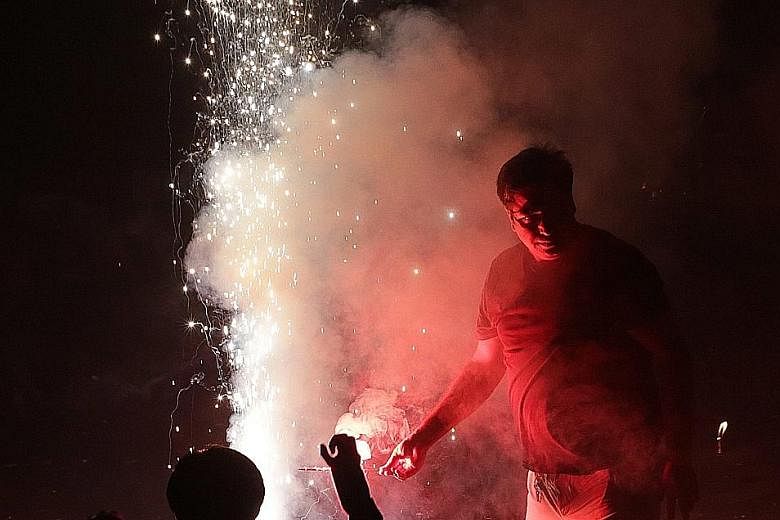NEW DELHI • New Delhi was shrouded in a thick blanket of toxic smog yesterday after millions of Indians lit firecrackers to mark the Diwali festival, with the authorities reporting record levels of pollution in parts of the capital.
The reading for the level of pollutants in the atmosphere breached the 1,000 microgram mark for the first time in one neighbourhood in south Delhi - 10 times the World Health Organisation's (WHO) recommended level.
Dr Gufran Beig, chief scientist at India's state-run System of Air Quality Weather Forecasting and Research (Safar), said needles on monitors in the RK Puram neighbourhood had flickered briefly past the 1,000 level late on Sunday night at the finale of a frenzy of fireworks.
The levels had subsided through the night but were still running at more than 700 in several districts across the capital by mid-morning.
"Almost 60 to 70 per cent of the smoke came from the firecrackers," said Dr Beig, who said the situation had been widely expected, given that Diwali is always one of the worst periods for pollution.
"It was already predicted that the levels would increase several notches," he said.
In a health advisory on its website, Safar said there was a "serious risk" of respiratory problems for people living in Delhi and everyone should avoid all physical activity outdoors. People with heart or lung disease, older adults and children should stay indoors and keep activity levels low, it added.
Levels of pollution traditionally surge over Diwali but the situation this year was exacerbated by high levels of moisture in the air and the burning of agricultural residue by farmers on the outskirts of the capital or in neighbouring states, Dr Beig added.
New Delhi's air quality has steadily worsened over the years, a consequence of rapid urbanisation that brings pollution from diesel engines, coal-fired power plants and industrial emissions.
It also suffers from atmospheric dust, burning of crop stubble in farms around the city and pollution from open fires lit by the urban poor to keep warm in winter or to cook food.
The authorities have responded with measures such as a ban on old trucks from entering the city and briefly trialling a scheme that limited private vehicle usage to alternate days, but experts say they have done little to reduce pollution.
India is home to four of the world's 10 cities with the worst air pollution, the WHO said in May. New Delhi ranked 11th.
Delhi's government last week announced plans to install air purifiers and a mist-making device at major intersections to curb choking pollution.
But unlike China, which has some major cities also plagued by severe air pollution at times, India does not have any policies to shut schools or offices even when air quality deteriorates to extreme levels for days.
"Where is the plan for short- and medium-term action, and for emergency action?" said Ms Anumita Roychowdhury of the Centre for Science and Environment. "We need one very urgently."
AGENCE FRANCE-PRESSE, REUTERS

